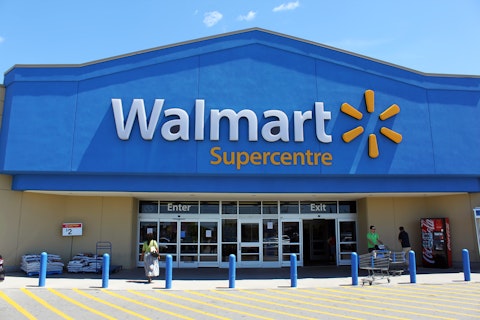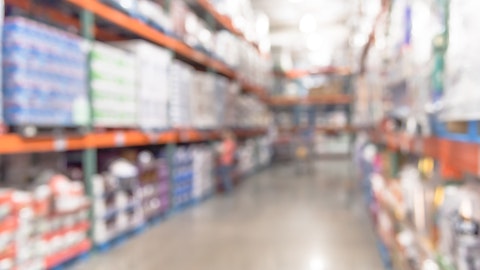Walmart Inc. (NYSE:WMT) Q2 2024 Earnings Call Transcript August 17, 2023
Walmart Inc. beats earnings expectations. Reported EPS is $1.84, expectations were $1.69.
Operator: Greetings. Welcome to Walmart’s Fiscal Year 2024 Second Quarter Earnings Call. [Operator Instructions] Please note this conference is being recorded. At this time, I will now turn the conference over to Steph Wissink, Senior Vice President, Investor Relations. Steph, you may now begin.
Steph Wissink: Thank you, and welcome, everyone. We’re excited to discuss with you the results of a strong second quarter and our upwardly revised outlook for the year. Joining me are Walmart’s CEO, Doug McMillon, and CFO, John David Rainey. Following prepared remarks from Doug and John David, we’ll take your questions. At that time, we will be joined by our segment CEOs: John Furner from Walmart U.S., Judith McKenna from Walmart International, and Kath McLay from Sam’s Club. [Operator Instructions] Today’s call is being recorded, and management may make forward-looking statements. These statements are subject to risks and uncertainties that could cause actual results to differ materially from these statements. These risks and uncertainties include, but are not limited to, the factors identified in our filings with the SEC.
Please review our press release and accompanying slide presentation for a cautionary statement regarding forward-looking statements, as well as our entire Safe Harbor statement and non-GAAP reconciliations on our website at stock.walmart.com. Thank you for your interest in Walmart. Doug, we are now ready to begin.
Doug McMillon: Good morning, everyone and thanks for joining us. We had another strong quarter. We’re gaining share across markets and formats, growing units sold, transaction counts are positive across markets and growth in operating income is outpacing sales. We’re really pleased with our first half performance. For the quarter, comp sales for Walmart U.S. were ahead of where we thought they’d be at 6.4%. Sam’s Club U.S. was 5.5% and sales for international were up 11%, led by double-digit growth at Walmex and China. Flipkart’s GMV was also strong. The team is driving results in the short-term and building for the future. We’re a people-led, tech-powered, omnichannel retailer dedicated to helping people save money and live better.
We like who we are and we like who we are becoming. We’re positioned for growth. We can serve people how they want to be served whether that’s in a store club, picking up an order curbside or having it delivered. We continue to grow some of our newer businesses which shape the overall model in a positive way, helping to enable us to grow profit faster than sales. We’re setting the right capital priorities, and you can expect us to continue investing in the areas we’ve talked about, like technology, including automation, store and club remodels, and with new stores and clubs in select markets. As it relates to technology, our approach to new tools like generative AI is to focus on making shopping easier and more convenient for our customers and members and helping our associates enjoy more satisfying and productive work.
Ultimately, the power of generative AI or any technology is only as good as the data that powers it. Our data assets are unique, and we’re excited about the potential to leverage them in new and impactful ways. We’re taking large language models developed by our partners and by the broader tech community and adding retail context to create models that are uniquely suited to the needs of our customers, our associates and our supply chain. We’ll unlock value for shareholders through the combination of our physical automation work with our data and increasingly intelligent software. We have a sharp focus on ROI as we drive results and set our capital priorities. The financial framework we laid out at our Investment Community Meeting in April is evident in our results from the last two quarters.
The remodel program I mentioned includes items to support our goal of becoming a regenerative company, as we put things like new refrigeration equipment and EV charging stations in place. I was in Chile last week where I got to participate in the grand opening of a new hydrogen plant in Santiago that supports our strong business in that country. While I’m on the subject of regeneration, we recently announced a new collaboration focused on supporting U.S. and Canadian farmers to help improve soil health and water quality. Our collective goal is to enable and accelerate the adoption of regenerative agricultural practices on more than 2 million acres of farmland and deliver 4 million metric tons of greenhouse gas emission reductions and removals by 2030.
Some days I still get amazed by all the good work happening across our company. As a global retailer, we see how our customers and members are affected by what’s happening at a macro level, and how that influences their behaviors. Jobs, wages and pockets of disinflation are helping our customers, but rising energy prices, resuming student loan payments, higher borrowing costs, and tightening lending standards and a drawdown in excess savings mean that household budgets are still under pressure. I was in Calgary visiting stores a couple of weeks ago, and our Canadian customers are feeling the pinch of higher interest rates faster than in the U.S. given their shorter-term mortgages. When you put all this together, we see families that are discerning about what they’re spending on.
They’re setting priorities and spending on the things they care most about. We saw that during the first half of the year with Chinese New Year and Easter, and more recently with July 4th and the start of Back to School, where sales are ahead of plan so far. We see them buying more private brand items, and they’re buying more grocery staples and in-home meal options consistent with eating at home. Our customers and members are resilient. They’re looking for value, and they trust us to be there for them. We see people across income cohorts come to us more frequently looking to save money on everyday needs. That gives us an opportunity to drive conversion in more discretionary categories. We’re encouraged by how general merchandise performed during the second quarter versus our expectations.
We still expect food, consumables and health and wellness, primarily due to the popularity of some GLP-1 drugs to grow as a percent to total in the back half. But the trends we see in general merchandise sales make us feel more optimistic about those categories in the back half of the year. Our stores and clubs give us a competitive advantage and power our omnichannel model. Our curbside pickup business continues to grow as people look for ways to save time, and store-fulfilled delivery is now growing faster than pickup across all three segments. Delivery speed and accuracy are obviously important, and we lack how we’re leveraging our physical assets. In the U.S., we have more than 4,000 stores and nearly 600 Sam’s Clubs making same-day deliveries, and in nearly 2,000 stores and clubs internationally.
We’re increasingly measuring those deliveries in hours rather than days. In China, where we deliver from all our stores, nearly 80% of digital orders are delivered in under one hour. I like how we’re constantly improving delivery speed. It’s important to our customers and to our strategy, and I like how we’re building mutually reinforcing businesses. Running great stores and scaling e-commerce are and will be our top priorities. The way we design them along with our marketplace, fulfillment services and advertising business is key. We’ll keep prioritizing omni-retail, but we have good opportunities in healthcare and financial services in multiple markets. The growth of PhonePe has been fantastic, and we’re building other financial products like Cashi in Mexico and through ONE here in the U.S. We continue to build our healthcare services capabilities with clinic expansion.
As I look at the remainder of the year, our immediate focus is on getting product costs and retails down to fight inflation, which will help with mix, improving execution of pickup and delivery orders, expense management and inventory management by item and category. I’ll wrap up by saying a big thank you to our associates. As always, they’re making a difference every day for our customers and members. As we close out Back-to-school and get ready for the holidays, their execution day-to-day and commitment to our customers and members is as critical as ever. Thank you for your interest in our company. Over to you, John David.
John David Rainey: Thanks, Doug. I’d like to start by thanking our customers, associates and partners for helping us deliver another strong quarter with better-than-expected results in sales, operating income and adjusted EPS. Sales were strong across all segments, and we gained U.S. market share in grocery in both units and dollars, while delivering gross margin rate expansion. Our focus on saving customers’ time and money continues to resonate, especially in high volume seasonal periods. We have good momentum in the business. Year-to-date, we grew sales by over 6.5%, adjusted operating income by about 12%, and adjusted EPS by roughly 8%. With our Q2 results coming in better than expected, we’re increasing our full-year guidance, and we’re well positioned as we enter the back half.
I’ll discuss guidance shortly, but first I’d like to review highlights of our Q2 results using our financial framework of growth, margins and returns. Starting with growth. For the second quarter, constant currency sales increased 5.5%, or more than $8 billion. Walmart U.S. comp sales excluding fuel increased 6.4%, with growth in both store and digital transactions. Grocery, and health and wellness sales continued to outperform, and we are encouraged by the modest sequential improvement in general merchandise. E-commerce sales were up 24%, driven by store fulfilled pickup and delivery and advertising. We like the trends we’re seeing in e-commerce. Customers are increasingly counting on us for convenience, and they’re visiting our app and sites more often.
In Q2, weekly active digital users grew more than 20%. Similar to Q1, consumer spending remains resilient at the headline level. Customers are stretching their dollars further and seeking better value across more categories more often. We see grocery staples and in-home meal options being purchased more often. Sales of general merchandise kitchen tools like hand blenders and stand mixers have inflected higher as customers are preparing more food at home. They’re also buying more necessities and focusing on lower-priced items and brands, and customers still want to celebrate key moments. Over the last year here in the U.S., we’ve partnered with suppliers to utilize rollbacks and offer select seasonal baskets of goods at the same prices as last year, essentially removing the impact of inflation.
Customer response has been strong, and sales have exceeded plan for events like Memorial Day, 4 July and our Walmart Plus Week Savings event. We’re taking a similar inflation-fighting approach to Back-to-school, with a basket of 14 of the most popular classroom essentials for under $13. In our international segment, sales were strong, up 11% on a constant currency basis, led by double-digit growth in Walmex, China and Flipkart. E-commerce grew 26%, and we experienced positive store traffic across markets. Similar to the U.S., customers are still pressured by elevated inflation with spend over indexing towards food and consumables. We’re seeing higher private brand penetration across markets as customers globally look for a combination of value and quality.
And Sam’s Club U.S. comp sales excluding fuel increased more than 5% with member fee income up 7%. On margins, consolidated gross margins increased 50 basis points as we lapped last year’s elevated levels of inventory markdowns and supply chain costs. These tailwinds were partially offset by ongoing category mix pressure, as grocery and health and wellness sales outperformed general merchandise. One of our strategic priorities is improving digital margins with an eye towards e-commerce profitability. I’m pleased with the progress we are making, particularly in Walmart U.S. contribution profit, which has been driven by fulfillment efficiencies and better product margins. We’re leveraging our stores to fulfill more than 50% of digital orders, and activating our local delivery networks to get product to customers faster at lower cost.
At our Investment Community Meeting in April, I said that we expected 200 basis points of improvement in contribution profit this year, and we’re on track to achieve that goal. We’re also pleased with performance of our higher margin growth initiatives that reinforce our core omni retail model. I’ll provide highlights on each of these. First, marketplace. We’re continuing to scale our marketplace in the U.S. with new items and sellers. The number of customers buying items on our marketplace increased 14% in Q2. Sales were strong in both consumables and general merchandise categories, with double-digit growth across home, apparel and hardlines, and the number of sellers utilizing our fulfillment services increased more than 50%. In Mexico, we also expanded the number of sellers and items available on the marketplace, resulting in 40% GMV growth for the quarter.
In Canada, we opened our first automated e-commerce fulfillment center in Alberta, which includes Walmart Fulfillment Services and expands two-day shipping to 97% of households. And in India, Flipkart’s Myntra is the country’s largest e-commerce marketplace for fashion and lifestyle products, offering top brands to customers across India. Myntra now provides access to more than 6,000 brands on its marketplace. Moving to advertising. Our global advertising business delivered strong growth of approximately 35%. In the U.S., Walmart Connect sales increased 36% in Q2, and the business has nearly doubled in size over the past two years. We’re seeing strong growth in sponsored ads and increased demand for in-store activation. Advertiser count grew 60%, with strong momentum in new advertisers.
Sam’s advertising business grew 33%. The in-club sales attribution feature for search and sponsored ads has generated strong interest from advertisers. On average, advertisers are seeing a nearly 30% improvement on the returns of digital ad spend as they gain full visibility to the member journey from intent to purchase, both online and in-clubs. And in international, the advertising business grew nearly 40%. And lastly, membership, Sam’s Club U.S. member counts increased mid-single digits with strong plus membership growth in renewals as plus penetration is up 1.3 percentage points versus last year. During the quarter, we achieved record member acquisition tied to Walmart Plus Week and continued to enhance the value of the Walmart Plus membership.
We introduced Walmart Plus Assist, which provides a 50% discount off the regular membership fee for customers receiving government assistance. We also partnered with Expedia Group to launch new travel benefits for members. Turning back to the middle of the P&L. As expected, SG&A expenses were higher versus last year and deleveraged 33 basis points. This reflects higher variable pay expenses relative to last year when we were below our planned performance, tech investments and increased store remodel cost in the U.S. Partially offsetting this, international expenses leveraged significantly on strong sales growth. As we increasingly utilize technology in our business, we’re pleased with the performance metrics from our newly automated distribution and fulfillment notes.
Our automated e-commerce fulfillment centers are achieving efficiencies of 30% higher units per hour than non-automated buildings. We’re also seeing increased productivity from the more than 15% of stores now being served by automated regional distribution centers. It’s early in the rollout process, but we are encouraged that some of these facilities are driving operating leverage well beyond our initial expectations. Second quarter adjusted operating income grew more than 8%, and our adjusted EPS of $1.84 was up 4%. Our plan is to grow operating income faster than sales, and our second quarter performance achieved this despite lapping the $173 million insurance settlement that benefited international’s other income last year. Similar to Q1, below-the-line items were pressured by higher net interest expense, reflecting the increase in rates and noncontrolling interest due in part to stronger results from Walmex.
The team continued to do a good job managing inventory, and we ended the quarter down 5%, including an 8% decline in Walmart U.S. We feel good about the progress we’ve made on in-stock levels as supply chain is normalized and the composition of our inventory mix is improved. We’re maintaining discipline in how we’re buying general merchandise during this uncertain macro environment to mitigate future risk if demand softens. ROI or return on investment, declined 100 basis points. As a reminder, we calculate ROI on a trailing 12-month basis, and the decline in Q2 is a result of nearly $4.2 billion in charges we incurred in Q3 and Q4 last year, related primarily to the opioid legal settlement framework and the separation of Flipkart and PhonePe. Together, these negatively impacted second quarter ROI by 140 basis points.
As we lap these discrete charges in the coming quarters, we expect a stronger ROI inflection in the back half of the year. We’re also starting to realize some benefits from productivity initiatives that were initially planned for fiscal year ’25, and we continue to expect our ROI to increase over the coming years. I’ll now briefly discuss some additional Q2 highlights for each segment. For Walmart U.S., our 6.4% sales comp included a high single-digit increase in grocery and a high-teens increase in health and wellness. Although general merchandise sales declined low single digits versus last year, these results were 300 basis points better than Q1, aided by outperformance from early Back to School shopping in our Walmart Plus savings event.
We saw a 240-basis point shift in sales mix from general merchandise to grocery and health and wellness in Q2. Grocery inflation moderated more than 400 basis points from Q1 levels and more than 700 basis points year-over-year to a high single digit increase as we lapped higher levels from last year. On a two-year stack, grocery inflation remained over 20%. We’re encouraged by the growth in units sold, particularly in food categories where disinflation is more pronounced, such as fresh meats, seafood and eggs. In addition, private brand sales in grocery were up more than 9%, with penetration up nearly 40 basis points in Q2 and up more than 170 basis points on two-year stack. Lower markdowns and supply chain cost resulted in a gross margin rate increase of 40 basis points, despite ongoing pressure from category mix shifts.
The negative impact to margin mix from outsized growth in branded drugs accelerated in Q2. Other income grew nearly 4%, led by continued growth in Walmart+memberships. And overall, Walmart U.S. operating income increased 7.6%. Our international segment delivered another impressive quarter with double-digit sales growth and strong underlying profit growth. Operating income increased 2.2%, but was negatively impacted by 20 percentage points from lapping last year’s insurance recovery that I mentioned earlier. Walmex had another strong quarter with sales up 10%, reflecting strength in our Bodega stores, Sam’s Club and E-commerce. E-commerce sales grew in the low 20s, with traffic up more than 5%. Walmex is an excellent example of our omnichannel retail strength across formats and channels.
Bodega Aurrera is celebrating its 65th anniversary and has become the most valuable retail brand in Mexico. These Bodega stores have consistently delivered strong performance and continue to accelerate e-commerce to better serve customers, now offering more than 60,000 SKUs from 586 stores in 299 cities. In China, sales increased 22%, led by strength from Sam’s Club and e-commerce. We’re executing well with increased online and offline traffic across both the Sam’s and hypermarket formats. In India, Flipkart delivered strong GMV and net sales growth as the core business continues to perform well. The team continues to focus on expanding the ecosystem of products and services like advertising, travel and healthcare, and on delivering continued contribution profit improvement.
Flipkart’s consistent progress and performance reinforces our confidence in the long-term value of this business. India is leading the largest digital transformation in the world, and Flipkart is the leading marketplace in India, and we continue to be super impressed with PhonePe’s strong and consistent performance. Annualized TPV or total payment volume has surpassed $1.15 trillion, and for the first time, we processed more than 5 billion transactions in a single month. Sam’s Club delivered another strong quarter with solid unit growth and e-commerce up 18%. It’s encouraging to see members embrace omnichannel with strong in-club traffic gains and increasing engagement with our digital tools in and outside the Club. In Q2, utilization of Scan and Go increased 570 basis points, and curbside pickup saw double-digit growth.
Similar to Walmart, sales strength at Sam’s was led by grocery and healthcare categories as the members focused on value and essentials. While discretionary categories were pressured overall, items with compelling price and quality and strong value to market are driving sales. Sam’s Club operating income was up 22%, due in part to lower LIFO charges. Turning to guidance. There continues to be a reasonable level of uncertainty in the economic backdrop for the balance of this year. While inflation has moderated and employment levels have been steady, credit markets have tightened, energy prices are higher, and some customers face additional expense from the resumption of student loan payments in October. As such, we continue to be appropriately measured in our outlook.
We’re raising our full year guidance to reflect Q2 performance and our expectations for Q3. I’ll highlight the key changes, but please refer to the press release for a full list of updated metrics. For the full year, we now expect net sales in constant currency to grow approximately 4% to 4.5%. We now anticipate LIFO will be a $200 million charge to operating income versus the $500 million charge that was in our prior guide. We expect operating income in constant currency to increase approximately 7% to 7.5%. This now assumes a 30 basis point year-over-year tailwind from LIFO compared to our prior guidance, which assumed a 100 basis point headwind. And we estimate adjusted EPS to be in a range of $6.36 to $6.46, including an expected $0.05 impact from LIFO.
To bridge to our prior guide, we flowed through the Q2 beat, removed the Walmart U.S. LIFO charges that were previously expected in Q3 and Q4 and modestly raised our sales expectations. Looking at Q3, we’re now offering the following view. We expect net sales growth in constant currency of approximately 3%. Operating income growth in constant currency is expected to be approximately 1%. This year-over-year growth is impacted by several comparison factors. We expect ongoing mix pressure impacts to gross margin to continue in Q3. We also expect a negative impact from fuel margins at Sam’s Club versus last year’s elevated levels. And similar to Q2, variable pay expense is expected to be higher in Q3 versus last year when we were below our planned performance.
We don’t typically guide currency, but it’s worth noting that if rates stayed where they are currently, we’d see a $1.6 billion benefit to Q3 reported sales and reported operating income growth would be closer to 3.5%. And lastly, we expect Q3 adjusted EPS of $1.45 to $1.50. In closing, we’re pleased with the strong first half of the year, and we positioned the business favorably for the back half. Our financial performance is validating our omnichannel strategy, driving organic sales growth while improving margins and returns. We’re optimistic about our ability to improve our performance even more in the future. We like our position. And now I’ll hand it back to [Doug] for a few comments before the operator opens the line for questions.
Doug McMillon: Thank you, John, David. Before we take your questions, I want to say a few words about the leadership changes we shared yesterday. Let’s start by celebrating Judith. She has done a fantastic job in many roles over the 27 years she’s been part of our company. She leaves her most recent role having delivered strong results and having transformed the business. It’s a different portfolio, better positioned for the future, it’s better positioned for growth on the top and bottom line. She strengthened our culture and sets us up for a digital future at the same time. We’re grateful. We talked about Kath moving into the international leadership role. The results Kath and our team have delivered at Sam’s speak for themselves.
Her experience and passion to serve customers and members will take us to the next level. It will be fun to watch her impact around the world. Some of you met Chris Nicholas and know how capable he is. He joined us five years ago in a finance role but with previous experience in merchandising and operations in several markets around the world. He’ll keep our member obsession going in Sam’s Club U.S. and pick right off where Kath left off. We also shared yesterday that Kieran Shanahan will join John’s team and become our Walmart U.S. Chief Operating Officer. Kieran has 25 years with our company working in a wide variety of roles in all three segments. He is well prepared to lead this big team and the change that’s coming through our automation investments in the supply chain.
As they build these new roles, John, Kath, Chris and Kieran will have all four worked in all three operating segments of our business. There’s not only a lot of store and club expertise in this group, but there’s also a great deal of digital and e-commerce experience. These are omnichannel merchants that are purpose-driven proven leadership skills. The depth of leadership in our company is such an advantage, but times get passed and we keep running, keep changing and keep pushing things forward. I want to say congratulations to all of them. And now I’ll turn it back over to the operator. We’re happy to take your questions.
See also 11 Easiest Instruments to Learn for Adults and Retirees and 10 Best Big Name Stocks to Buy Now.
Q&A Session
Follow Walmart Inc. (NYSE:WMT)
Follow Walmart Inc. (NYSE:WMT)
Operator: [Operator Instructions] Thank you. And our first question is from the line of Robbie Ohmes with Bank of America. Please proceed with your question.
Robbie Ohmes: Hi. Thanks for taking my question. Doug, you mentioned that you’re seeing things in general merchandise, I think that make you more optimistic about the back half. Can you maybe talk about what you’re seeing? I think John David said something about disciplined buying in general merchandise, what are you seeing that’s making you optimistic? And how should we think about general merchandise? And maybe if you could also weave in there. I know that you guys have continued to mention the high income customer shopping. I think it’s been more grocery focused. Have you seen high-income customers broadening out into the rest of the store?
Doug McMillon: Robbie, this is Doug. I’ll go first and then John or others can add if they want to. What’s making a little bit better as the run rate compared to the previous quarter and how back-to-school started? And typically, when back-to-school is strong, it bodes well for what happens with Halloween and Christmas and GM in the back half. I do think our food and consumables percent to total in Walmart U.S. will still go up. Part of it is what’s happened with inflation and disinflation in the GM categories. But relative to what I would have thought 90 days ago or when we started the year, GM is holding up better than I would have guessed. And I just – I feel like that with our store managers and the merchants, we want to have an optimistic posture on GM as we go into the back half. Anybody want to add anything?
John Furner: Doug, I’d like to – I give credit to the team for improvements we made. If you think about where we were last year with inventory headwinds for this year. I was in stores this week, and it’s really clear that stores have the ability, and our merchandising their store with discretion appropriately. They’re on top of their markdowns. Back rooms are in much better shape. The second thing, I think that’s helping is the e-commerce team, has done a nice job launching new products, things like registry for teachers in classrooms and parents and lists. Those are all working and helping back-to-school. And then the last thing that I’d say is the team is doing a really nice job with seasonal events and holidays. One of the things that we hear consistently from customers right now as they’re looking forward to celebrating again, like they used to.
That’s a bit of a theme that’s coming through, and we certainly saw that from Memorial Day, July 4, back-to-school started strong. So, we look forward to the holiday. It’s going to be a big holiday season. There are a lot of dynamics, as John David and Doug said in the market. But we want – to remain very flexible and prepared to help people get together, and celebrate each of these holidays that in front of us.
John David Rainey: There are also categories of general merchandise that on our marketplace saw double-digit increases, things like home, apparel, hardlines, which really gives you an indication of how our business, is changing as we’re selling more third-party assortment.
John Furner: It is. And John David, I think our event, our plus event you mentioned in your remarks as well was a good example. We had a high level of participation from marketplace sellers. We’ve talked about the number of items available in the sites, up almost four extra a year ago. Our seller count has grown. The number of customers are growing. And Tom and the team have done a nice job building capabilities that will really help us in the future.





